A Trip into Serotonin
Audra McNamee and Luca Mazzucato
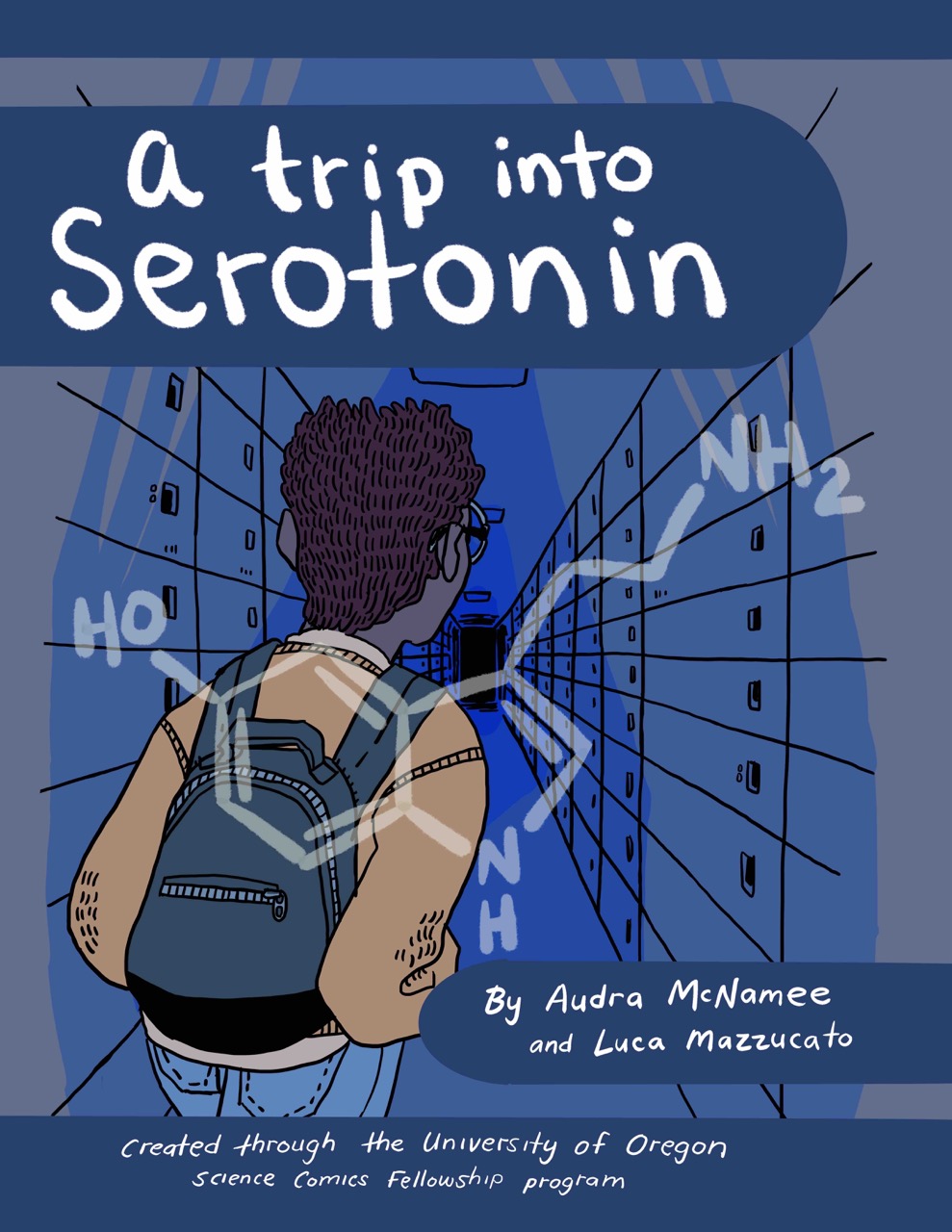
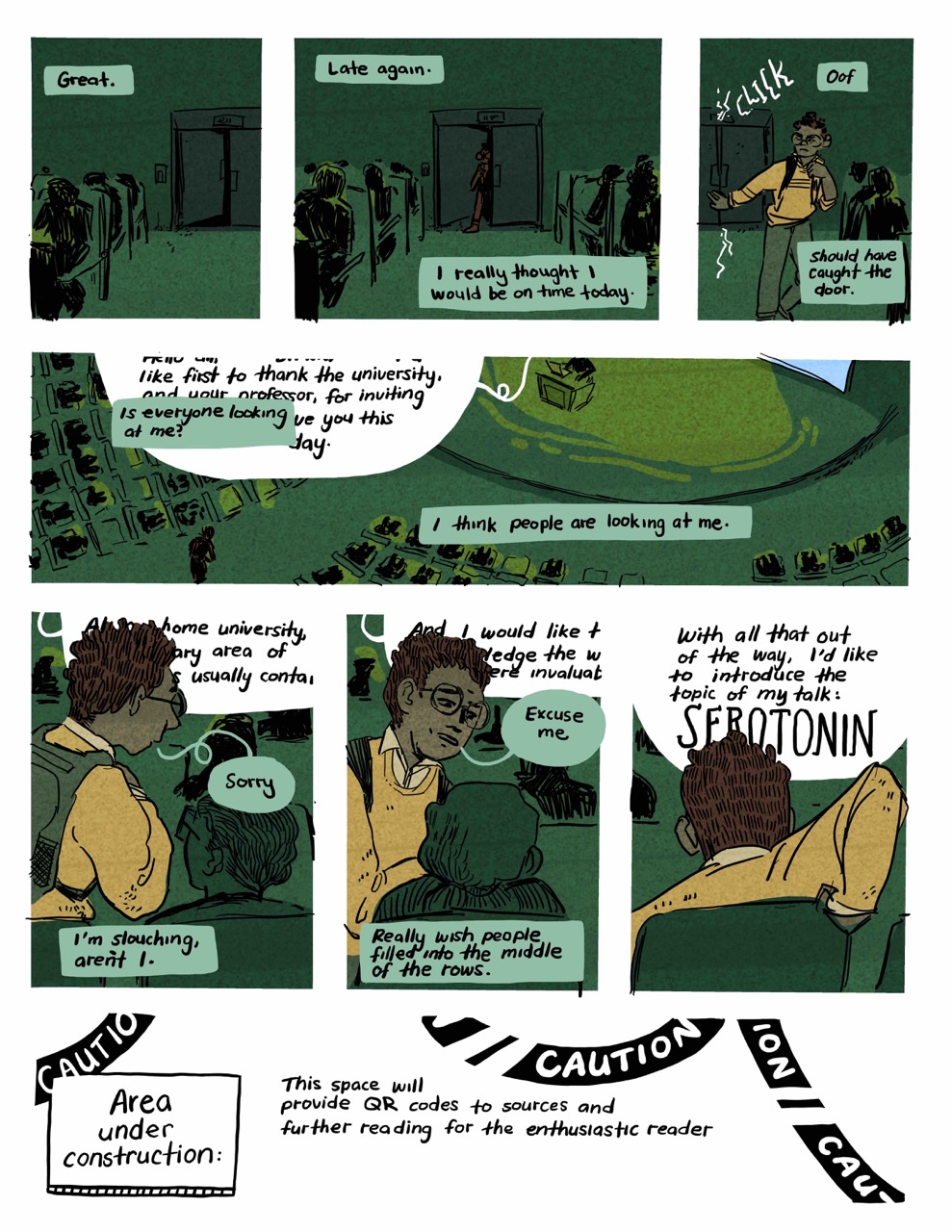
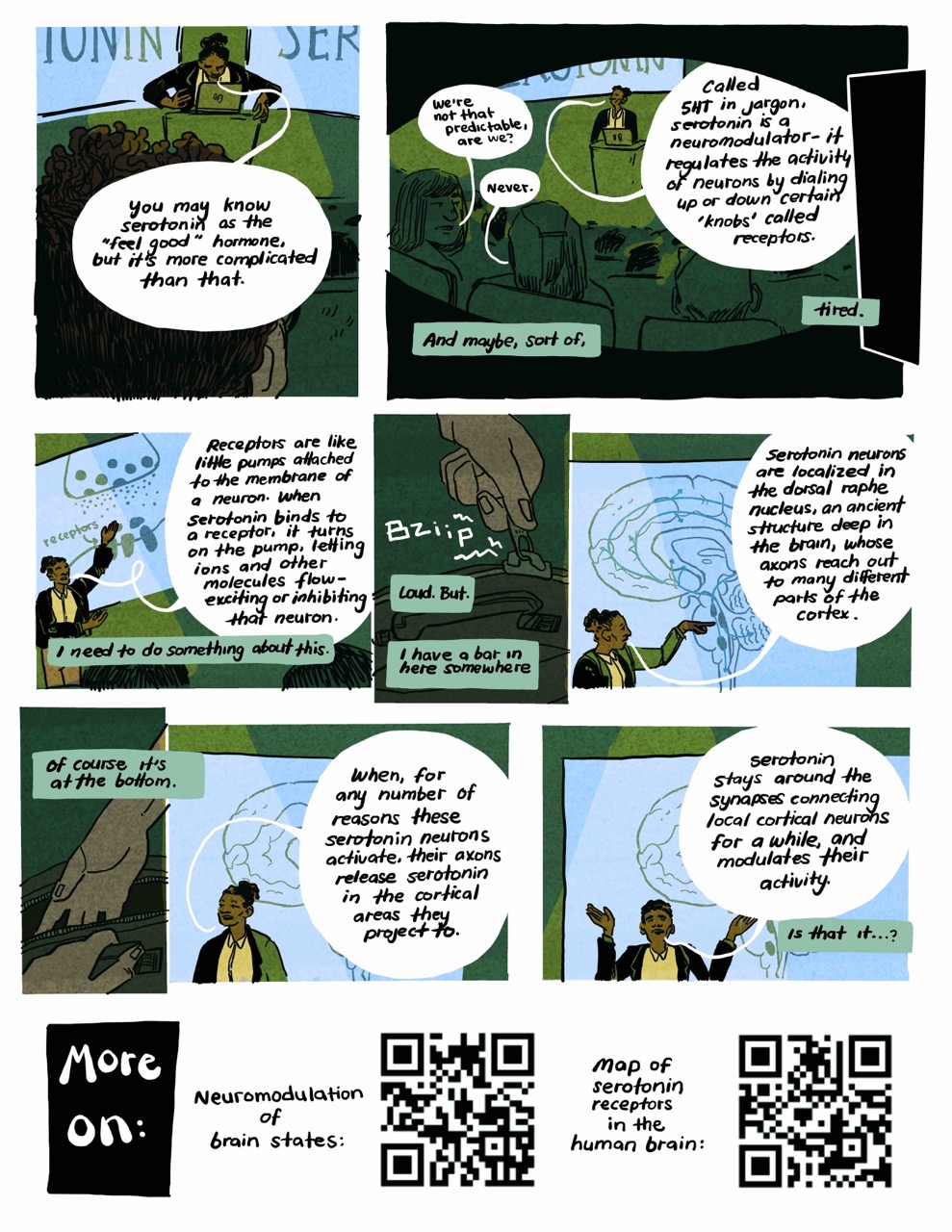
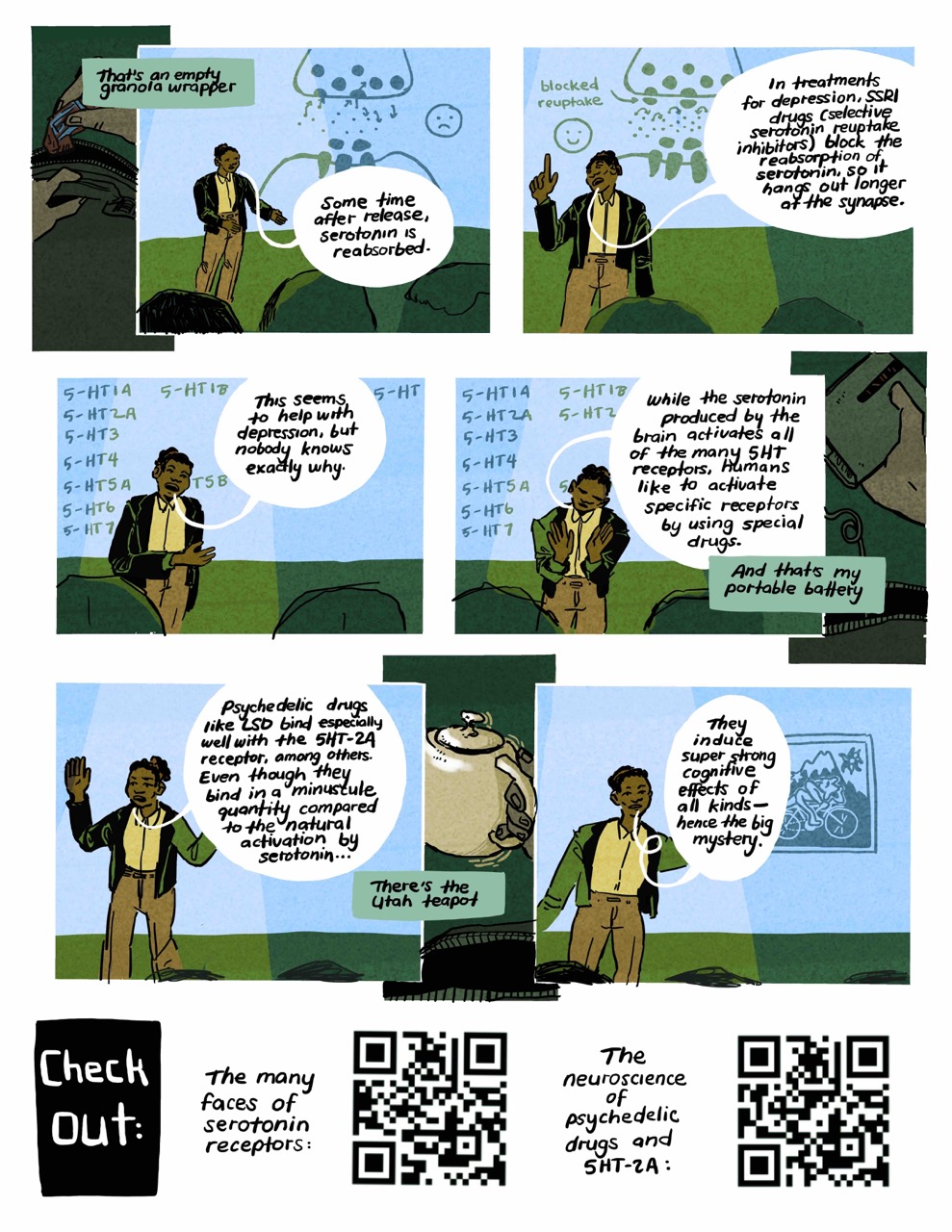
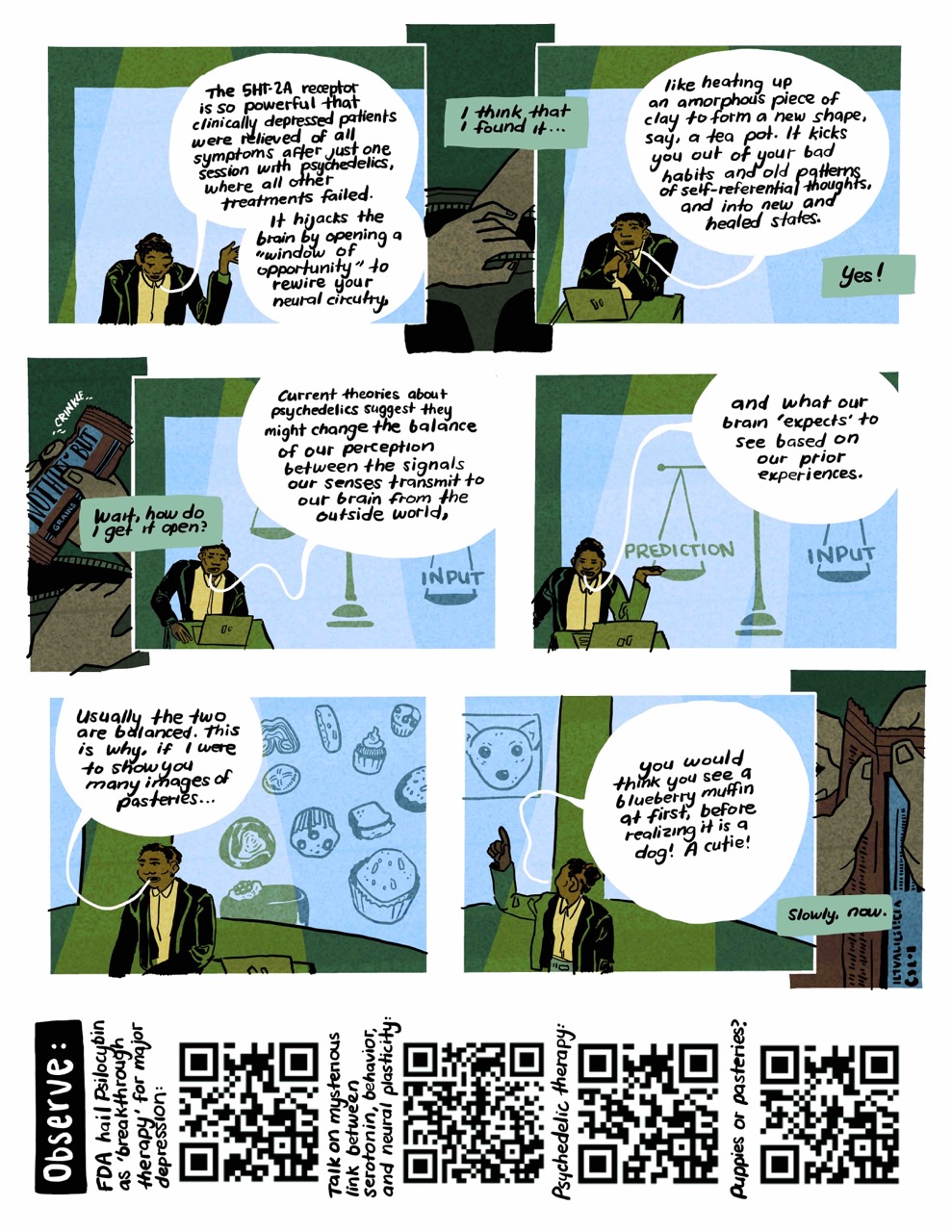
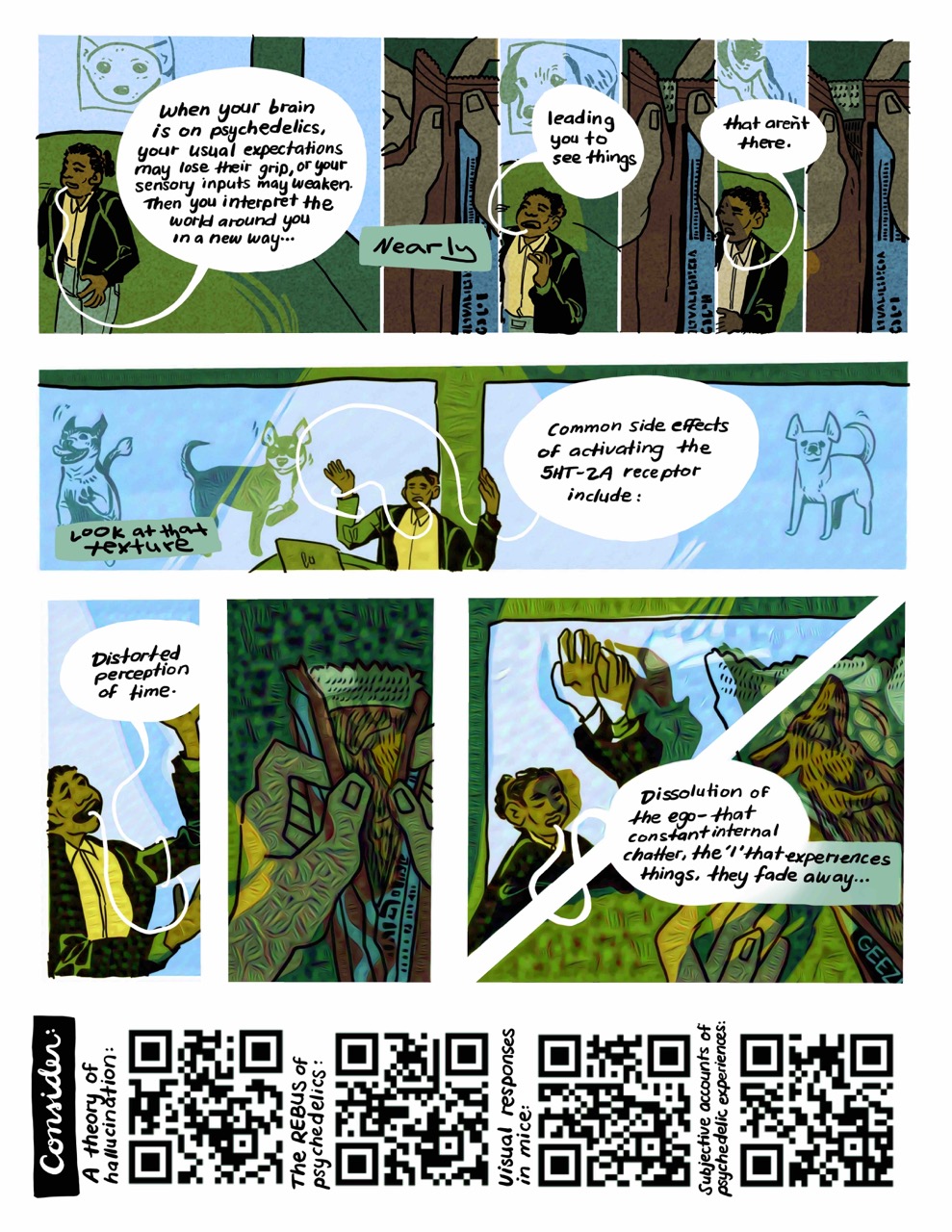
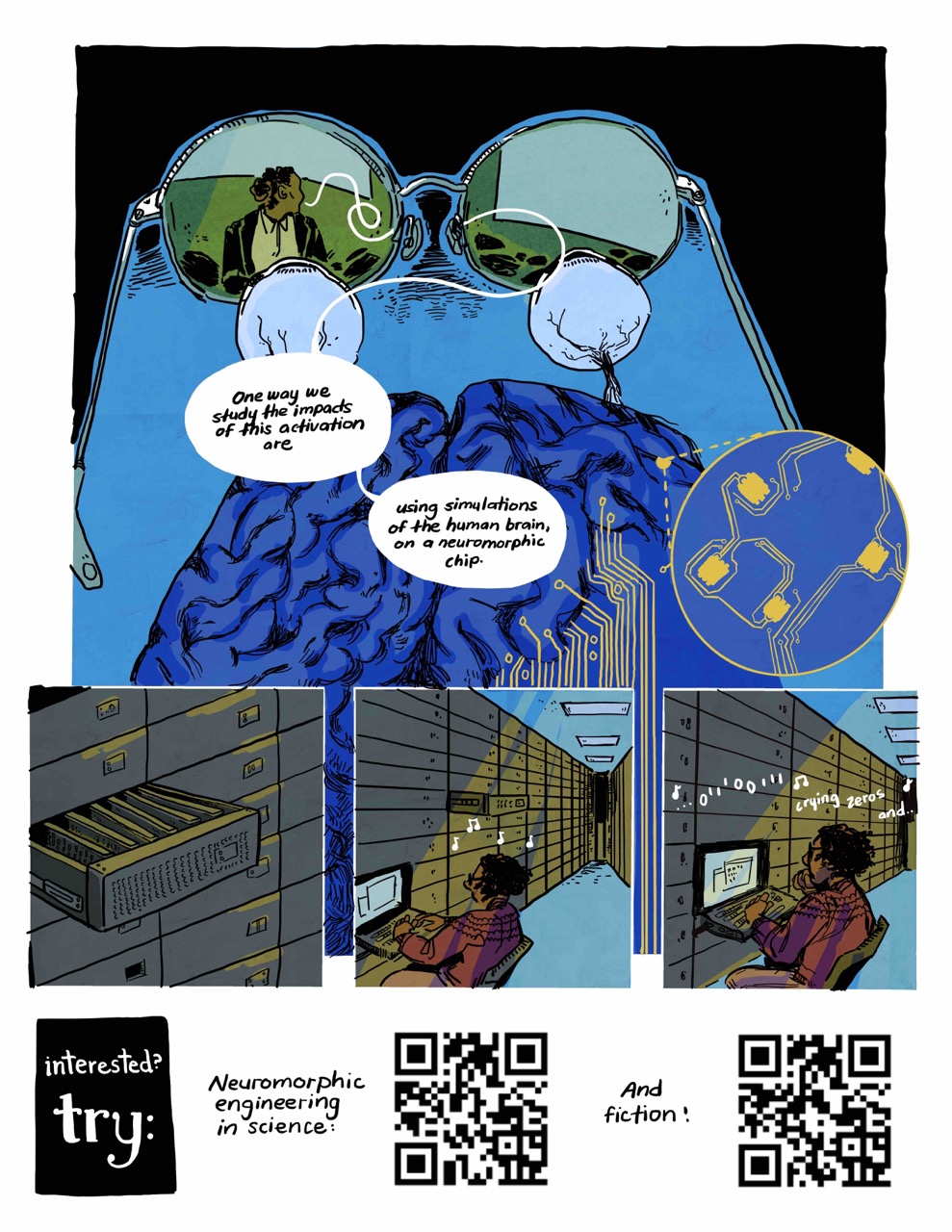
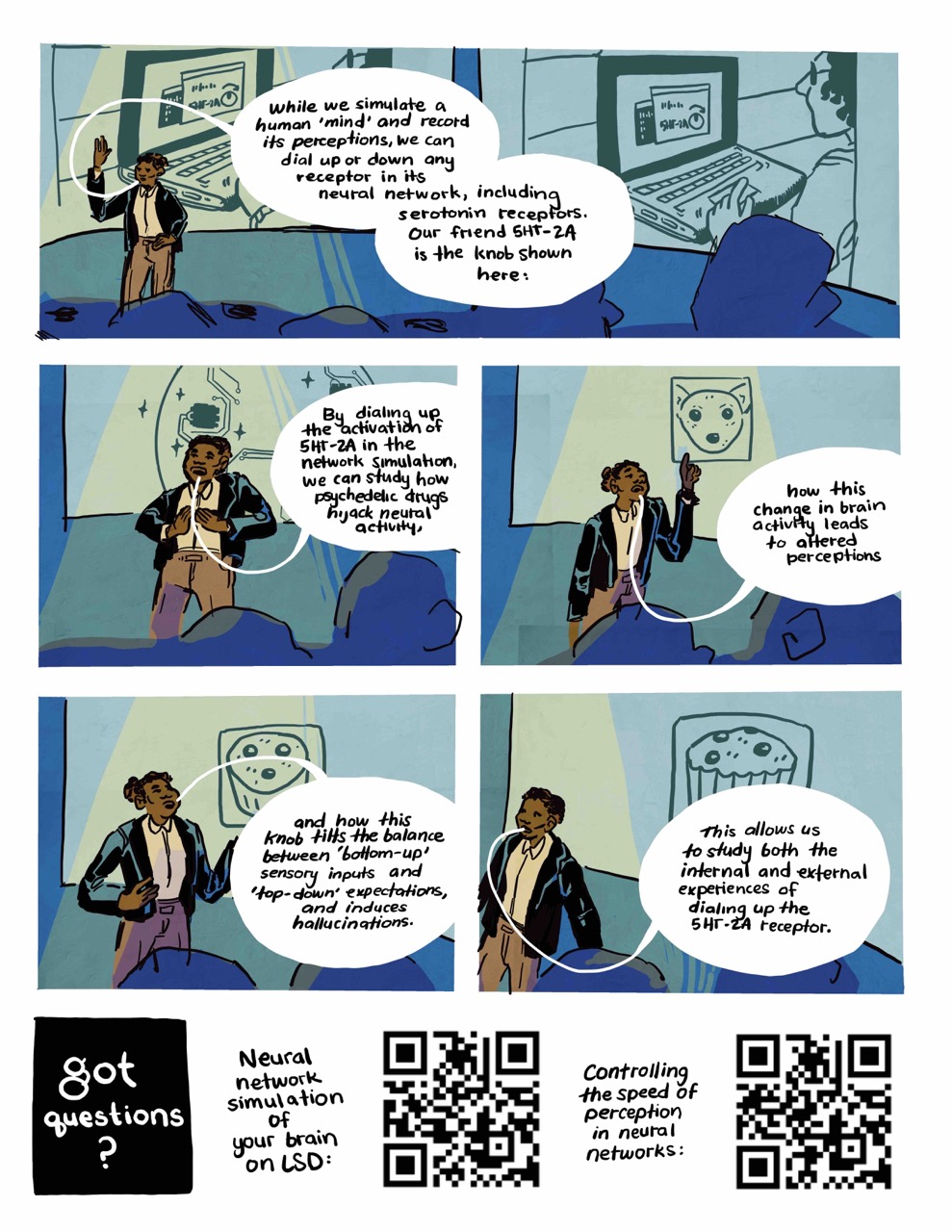
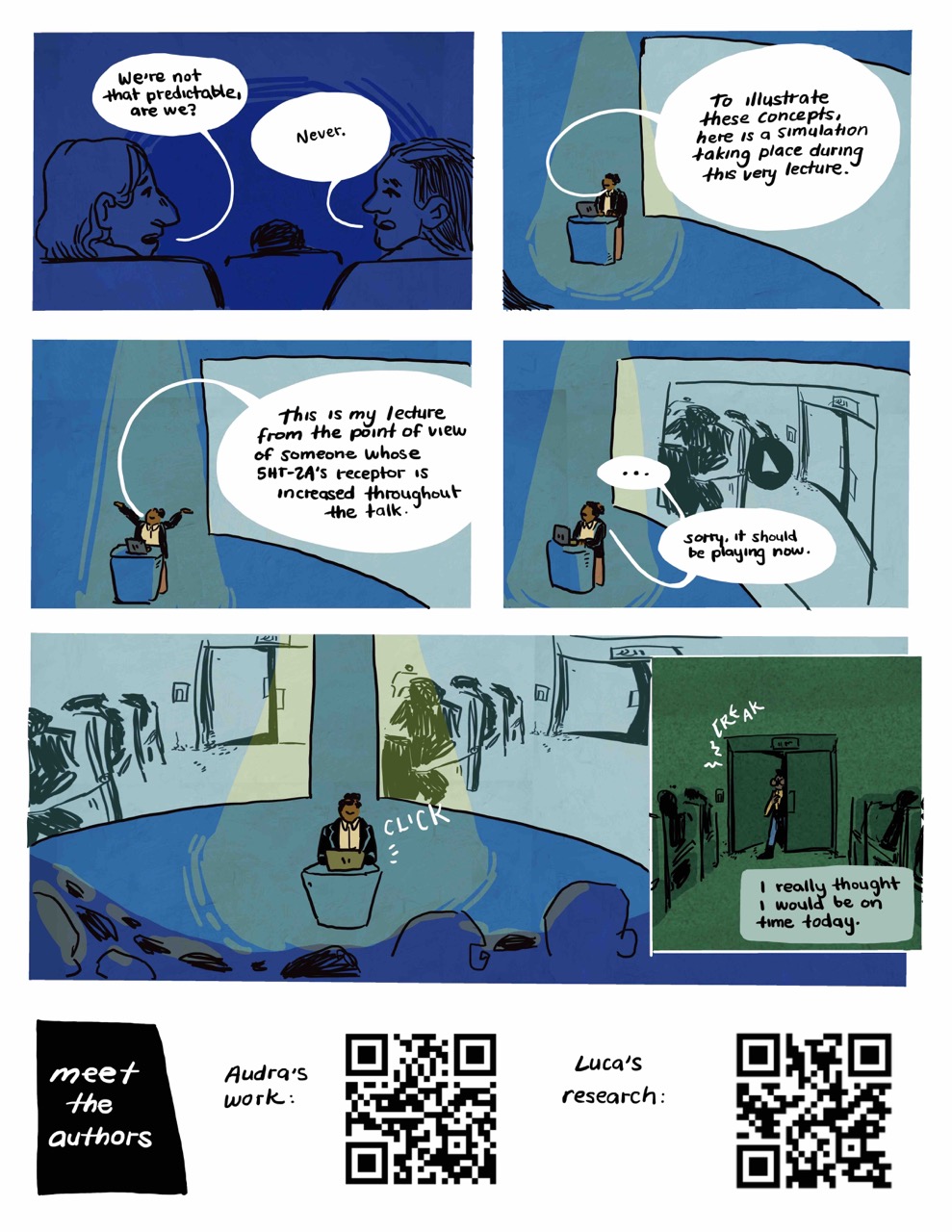
Transcript
Overview
A digitally drawn, hand lettered comic that uses a limited blue-green-brown color palette. The comic follows two threads simultaneously, cutting between them. One perspective is of a college student with short curly hair wearing a sweater over a collared shirt and a backpack. This character is referred to as “the Student” in this transcript. You often hear the Student’s inner monologue, and they also speak several times, when the student is speaking their dialogue is prefaced with “the Student:” The comic also follows a lecture that the Student is attending. The Lecturer is the other main speaker in the comic.
At the bottom of each page, where a final row of panels might go, are QR codes with links to sources and further reading. The QR codes are transcribed as links.
Cover
A Trip into Serotonin
By Audra McNamee and Luca Mazzucato
Created through the University of Oregon Science Comics Fellowship program
Cover description: The main character walks away from the viewer into an empty data center, past server racks. Superimposed over the cover is the molecular structure of serotonin.
Page 1
Panel 1: “Great” the slightly open double doors of a lecture hall with theater seating.
Panel 2: “Late again. I really thought I would be on time today.” The Student walks through the doors.
Panel 3: The doors close with a metallic “click.” “Oof. Should have caught the door.”
Panel 4: an aerial view of the large lecture hall, with a lecturer speaking at a podium. The Student in silhouette walks to their seat. “Is everyone looking at me? I think people are looking at me.” In the background the professor is talking, but their speech is obscured by the MC’s inner monologue: “…like first to thank the university and your professor, for inviting…you this…day.”
Panel 5: The Student scoots past people in a row of seats. Student: “Sorry” Inner monologue: “I’m slouching aren’t I.” The lecturer in the background: “…home university…area of…unusually…”
Panel 6: The Student continues to make their way to their seat. Student: “Excuse me” Inner monologue: “Really wish people filled into the middle of the rows.” Lecturer: “And I would like to acknowledge the…invaluable…”
Panel 7: The Student sits down. Lecturer: “with all that out of the way, I’d like to introduce the topic of my talk: Serotonin [emphasized]”
Page 2
Panel 1: The lecturer, a woman in a blazer with dark hair in a bun and dark skin, stands at the podium with a laptop. Behind her is a slide with the word “serotonin.” The back of the Student’s head is in the foreground. Lecturer: “You may know serotonin as the “feel good” hormone, but it’s more complicated than that.”
Panel 2: In the background the lecturer continues: “Called 5HT in jargon, serotonin is a neuromodulator – it regulates the activity of neurons by dialing up or down certain ‘knobs’ called receptors.” In the foreground two students talk to each other: “we’re not that predictable are we?” “Never.” The Student’s inner monologue: “And maybe, sort of, tired.”
Panel 3: The lecturer gestures to a diagram of a neuron receptor: “Receptors are like little pumps attached to the membrane of a neuron. When serotonin binds to a receptor, it turns on the pump, letting ions and other molecules flow- exciting or inhibiting that neuron.” Inner monologue: “I need to do something about this.”
Panel 4: Close up on the Student’s hand opening the zipper of their backpack. The zipper makes noise. Inner monologue: “Loud. But. I have a bar in here somewhere.”
Panel 5: The lecturer points to a structure close to the spinal column within a diagram of the brain, “serotonin neurons are localized in the dorsal raphe nucleus, an ancient structure deep in the brain, whose axons reach out to many different parts of the cortex.
Panel 6: The Student’s hands reach into their bag. Inner monologue: “Of course it’s at the bottom.”
Panel 7: The lecturer stands in front of the brain diagram, “When, for any number of reasons these serotonin neurons activate, their axons release serotonin in the cortical areas they project to.”
Panel 8: Lecturer: “Serotonin stays around the synapses connecting local cortical neurons for a while, and modulates their activity.” Inner monologue: “Is that it…?
Links: More on: neuromodulation of brain states. Map of serotonin receptors in the human brain [PDF].
Page 3
Panel 1: The student pulls a wrapper out of their bag. Monologue: “That’s an empty granola wrapper”
Panel 2: The lecturer stands in front of a diagram of a synapse showing the neurotransmitter being reabsorbed, labeled with a frowning face. Lecturer: “Some time after release, serotonin is reabsorbed.”
Panel 3: The slide changes to a synapse diagram labeled with a smiley face where reuptake is blocked. Lecturer: “In treatments for depression, SSRI drugs (selective serotonin reuptake inhibitors) block the reabsorption of serotonin, so it hangs out longer at the synapse.”
Panel 4: The lecturer stands in front of a slide with lots of receptor codes written on it (‘5-HT1A, 5-HT2A, 5-HT3, 5-HT1B….’). Lecturer: “this seems to help with depression, but nobody knows exactly why.”
Panel 5: Lecturer: “While the serotonin produced by the brain activates all of the many 5HT receptors, humans like to activate specific receptors by using special drugs.”
Panel 6: The Student pulls a battery pack out of their bag. Monologue: “And that’s my portable battery.”
Panel 7: The lecturer gestures, lecturer: “Psychedelic drugs like LSD bind especially well with the 5HT-2A receptor, among others. Even though they bind in a minuscule quantity compared to the natural activation by serotonin…”
Panel 8: The Student pulls a teapot out of their bag. Inner monologue: “There’s the Utah teapot.”
Panel 9: The Lecturer stands in front of a slide showing a classic blotter print, of a cyclist riding on a mountain, celebrating the invention of LSD. Lecturer: “They induce super strong cognitive effects of all kinds—hence the big mystery.”
Links: Check out: the many faces of serotonin receptors [PDF] . The neuroscience of psychedelic drugs and 5HT-2A.
Page 4
Panel 1: Lecturer: “the 5HT-2A receptor is so powerful that clinically depressed patients were relieved of all symptoms after just one session with psychedelics, where all other treatments failed. It hijacks the brain by opening a “window of opportunity” to rewire your neural circuitry.”
Panel 2: The student reaches back into the bag. Inner monologue: “I think that I found it…”
Panel 3: Lecturer: “like heating up an amorphous piece of clay to form a new shape, say, a tea pot. It kicks you out of your bad habits and old patterns of self-referential thoughts, and into new and healed states.” Inner monologue: “yes!”
Panel 4: The student pulls a ‘nothing but grains’ granola bar out of their bag, “crinkle.” Inner monologue: “Wait, how do I get it open?”
Panel 5: The lecturer stands in front of a slide that shows uneven scales, on the high side is prediction, on the low side is input. “Current theories about psychedelics suggest they might change the balance of our perception between the signals our senses transmit to our brain from the outside world,”
Panel 6: the slide changes so now the scales are balanced, “and what our brain ‘expects’ to see based on our prior experiences.”
Panel 7: The lecturer stands in front of a slide full of pictures of baked goods like cupcakes, pastries and muffins. “Usually, the two are balanced. This is why, if I were to show you many images of pastries…”
Panel 8: the slide shows a dog’s head, it looks sort of like a muffin. “you would think you see a blueberry muffin at first, before realizing it is a dog! A cutie!
Panel 9: a close up on the Student’s hands opening the granola bar’s wrapper. “Slowly, now”
Links: Observe: FDA hail Psilocybin as ‘breakthrough therapy’ for major depression, Talk on mysterious link between serotonin, behavior, and neural plasticity [YouTube Video], Psychedelic therapy, Puppies or pastries?
Page 5
Panel 1: Lecturer: “When your brain is on psychedelics, your usual expectation may lose their grip, or your sensory inputs may weaken. Then you interpret the world around you in a new way…” The slide behind her is still the dog face that looks like a muffin.
Panel 2: Close-up on the Student’s hands opening the bar, “nearly”
Panel 3: Lecturer: “leading you to see things” The dog head on the slide has transformed into a realistic puppy face.
Panel 4: Close-up on the wrapper starting to tear.
Panel 5: Lecturer: “that aren’t there.” On the slide we can only see the dog’s feet as it runs away.
Panel 6: the wrapper tears a little more.
Panel 7: the slide shows two happy dogs running around, another slide shows a dog wagging its tail. Inner monologue: “look at that texture,” the lecturer still stands at the podium in front of the slides, “Common side effects of activating the 5HT-2A receptor include:
Panel 8: the lecturer looks slightly warped and her clothes have more texture than in previous panels. She continues “Distorted perception of time.”
Panel 9: A close up on the granola bar in the Student’s hands, now mostly open, the entire panel is covered in swirling texture and color.
Panel 10: a diagonal split, in the top of the panel the lecturer gestures, but her arm is reflected so she has an extra hand. In the lower half of the panel, the granola bar still has a wrapper, but the bar has transformed into a dog. The entire panel is heavily textured. Lecturer: Dissolution of the ego – that constant internal chatter, the ‘I’ that experiences things, they fade away…”
Links, Consider: the REBUS of psychedelics, visual responses in mice [PDF], subjective accounts of psychedelic experiences.
Page 6
Panel 1: A disembodied brain connected to two eyeballs. The eyes are looking through the Student’s glasses. In the lenses of the glasses, we see the lecturer still speaking. “One way we study the impacts of this activation are using simulations of the human brain, on a neuromorphic chip. There are wires running out of the brain. A zoomed in sub-panel shows the circuits of a computer chip.
Panel 2: Close up on several neuromorphic chips inside a drawer on a server rack
Panel 3: The open drawer is next to the lecturer, who is humming to herself as she types on her computer. She’s sitting in a long row of countless server racks.
Panel 4: Still humming to herself, the lecturer pauses to think.
Links: Interested? Try: neuromorphic engineering in science, and neuromorphic engineering in fiction!
Page 7
Panel 1: The lecturer stands in front of a slide that shows the final image from the previous page of herself working on her computer. Now visible on her screen is a knob with a clockwise-pointing arrow labeled ‘5HT-2A.’ Lecturer: “While we simulate a human ‘mind’ and record its perceptions, we can dial up or down any receptor in its neural network, including serotonin receptors. Our friend 5HT-2A is the knob shown here:
Panel 2: The lecturer stands in front of a slide with circuitry on it. Lecturer: “By dialing up the activation of 5HT-2A in the network simulation, we can study how psychedelic drugs hijack neural activity,”
Panel 3: The lecturer points to a slide with the muffin-dog face, “how this change in brain activity leads to altered perceptions.”
Panel 4: The slide changes to a picture that looks more like an actual blueberry muffin, “and how this knob tilts the balance between ‘bottom-up’ sensory inputs and ‘top-down’ expectations, and induces hallucinations.”
Panel 5: The slide changes to a different image of a blueberry muffin, “this allows us to study both the internal and external experiences of dialing up the 5HT-2A receptor.”
Links: got questions? Neural network simulation of your brain on LSD [PDF], controlling the speed of perception in neural networks [PDF].
Page 8
Panel 1: Two students in the audience turn to each other “we’re not that predictable, are we?” “Never.”
Panel 2: The lecturer stands on stage in a spotlight, “to illustrate these concepts, here is a simulation taking place during this very lecture.”
Panel 2: The lecturer spreads her arms, “This is my lecture from the point of view of someone whose 5HT-2A’s receptor is increased throughout the talk.”
Panel 3: The lecturer pulls up a video on screen, the first frame is the first panel of this comic, as the Student opened the door to the lecture hall. The lecturer pauses for a moment (…) “sorry, it should be playing now.”
Panel 4: “Click” the screens show the first frame of the video.
Panel 5: “Creak” an identical panel to the second panel of this comic, the Student opens the double doors of the lecture hall, inner monologue: “I really thought I would be on time today.”
Meet the authors: Audra’s work, Luca’s research.


